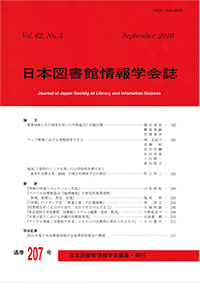All issues

Volume 45 (1999)
- Issue 4 Pages 141-
- Issue 3 Pages 95-
- Issue 2 Pages 45-
- Issue 1 Pages 1-
Predecessor
Volume 45, Issue 1
Displaying 1-3 of 3 articles from this issue
- |<
- <
- 1
- >
- >|
Article
-
Akira NEMOTOArticle type: Article
1999Volume 45Issue 1 Pages 1-16
Published: March 30, 1999
Released on J-STAGE: May 04, 2017
JOURNAL OPEN ACCESSDuring the Occupation Period (1945-1952) there were some American librarians who visited Japan and helped to reconstruct new library services in Japan, as an library administrators, as consultants and as educators of librarianship. This article is to analyze papers left at the ALA Archives, University of Illinois Urbana-Champaign Library, which records those activities to send, select and communicate with, them, of ALA/IRB (International Relations Board) Committee of Library Cooperation with the Orient and South Pacific. The chairman was the former ALA President Charles H. Brown. He showed the willingness to contribute to the educational reform by developing public libraries and school libraries when the First US Education Mission to Japan was sent in March 1946. But the focus was shifted from the library administration to such more indirect ones as training librarians after the first libraries officer Philip O. Keeney was discharged from his job for being sus-pected as a communist. It is not only because the occupation policy of the GHQ/SCAP (General Head Quarters, Supreme Commander for the Allied Powers) was shifted from liberal one to one which was reflected the Cold War anti-communism in 1947, but because Keeney had acted politically against the ALA in late 1930s during and after his tenure dispute.View full abstractDownload PDF (1995K) -
Mitsuyoshi MORIYAMAArticle type: Article
1999Volume 45Issue 1 Pages 17-34
Published: March 30, 1999
Released on J-STAGE: May 04, 2017
JOURNAL OPEN ACCESSThe prefectural union catalog networks in Japanese public libraries are loosely coupled structures in which only a small commitment from participating libraries in the networks is required. On the other hand, the bibliographic utilities, such as the National Center for Science Information Systems (NACSIS) which construct the union catalog networks require a high degree of commitment from participating libraries. Japanese public libraries buy almost all needed catalog data from private MARC (Machine Readable Cataloging) companies, and do not depend on the union catalog networks. Owing to this, the main objective of constructing the prefectural union catalog networks in the 1990s has been for interlibrary loans. The main catalog data processing method has shifted to the type in which the participating libraries in the network transmit their own catalog data extracted by batch process. We must resolve long-standing problems in Japanese public libraries with: 1) the coordination of different libraries' cataloging rules, 2) securing a budget, and 3) the discussion of private MARC copyright.View full abstractDownload PDF (2249K)
Article
-
Shokyu MINAMOTOArticle type: Article
1999Volume 45Issue 1 Pages 35-43
Published: March 30, 1999
Released on J-STAGE: May 04, 2017
JOURNAL OPEN ACCESSThis paper introduces and examines the content of the Manual of Map Library Classification and Cataloguing (known as MOD), which describes a map classification used by many map libraries and map rooms in the United Kingdom. The paper looks first at differences between map classification and book classification, demonstrating how the former is an area-based classification. The Manual classification basically consists of major classification area codes, colon number codes (indicating divisions), and specific colon numbers (showing compass point designanation and towns), and has nine hierarchical levels. As secondary classification, scales are used for maps and sizes (heights) for atlases. The paper also touches on how subjects are dealt with in the Manual. Finally it discusses the validity and limits of the Manual classification and introduces the author's views.View full abstractDownload PDF (1006K)
- |<
- <
- 1
- >
- >|